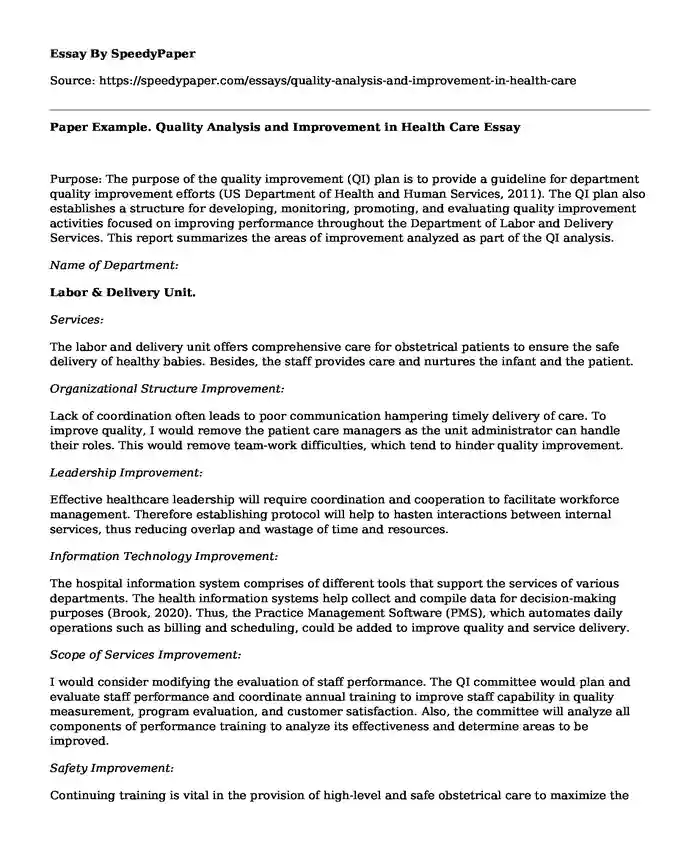
| Essay type: | Critical analysis essays |
| Categories: | Analysis Healthcare Human services |
| Pages: | 3 |
| Wordcount: | 598 words |
Purpose: The purpose of the quality improvement (QI) plan is to provide a guideline for department quality improvement efforts (US Department of Health and Human Services, 2011). The QI plan also establishes a structure for developing, monitoring, promoting, and evaluating quality improvement activities focused on improving performance throughout the Department of Labor and Delivery Services. This report summarizes the areas of improvement analyzed as part of the QI analysis.
Name of Department:
Labor & Delivery Unit.
Services:
The labor and delivery unit offers comprehensive care for obstetrical patients to ensure the safe delivery of healthy babies. Besides, the staff provides care and nurtures the infant and the patient.
Organizational Structure Improvement:
Lack of coordination often leads to poor communication hampering timely delivery of care. To improve quality, I would remove the patient care managers as the unit administrator can handle their roles. This would remove team-work difficulties, which tend to hinder quality improvement.
Leadership Improvement:
Effective healthcare leadership will require coordination and cooperation to facilitate workforce management. Therefore establishing protocol will help to hasten interactions between internal services, thus reducing overlap and wastage of time and resources.
Information Technology Improvement:
The hospital information system comprises of different tools that support the services of various departments. The health information systems help collect and compile data for decision-making purposes (Brook, 2020). Thus, the Practice Management Software (PMS), which automates daily operations such as billing and scheduling, could be added to improve quality and service delivery.
Scope of Services Improvement:
I would consider modifying the evaluation of staff performance. The QI committee would plan and evaluate staff performance and coordinate annual training to improve staff capability in quality measurement, program evaluation, and customer satisfaction. Also, the committee will analyze all components of performance training to analyze its effectiveness and determine areas to be improved.
Safety Improvement:
Continuing training is vital in the provision of high-level and safe obstetrical care to maximize the quality and safety of care. Implementing weekly training sessions on key areas in clinical obstetrics can equip obstetricians and L&D nurses with up-to-date clinical knowledge, thus improving the safety of patients.
Timeliness Improvement:
Digitizing hospital systems through the use of technological tools such as Electronic Medical Records (EMR) could help to reduce the wait and triage time in L&D units.
Effectiveness Improvement:
Providing care based on sound scientific knowledge would help to avoid underuse and misuse of hospital resources. Therefore, in the L&D unit, Caesarean Section is only offered to women who need it, in cases where vaginal delivery would put the mother or infant at risk.
Efficiency Improvement:
Technological advances can help reduce unit costs while simultaneously maintaining quality (Kronemyer, 2018). For example, telemedicine can reduce antenatal and postpartum care costs since it allows virtual consult between an obstetrician and a patient.
Equability Improvement:
Adoption of Telehealth services can ensure equitability in the delivery of obstetric care as it bridges barriers of ethnicity, socioeconomic status, and geographical location.
Patient-Centeredness Improvement:
Actively involving the patients in the decision-making process can help to improve the focus on their needs. Also, the patient's values, social context, and specific needs should be respected. Besides, providing individualized care is essential to build trust and confidence with the patients.
References
Brook, C. (2020, March 16). What is a Health Information System? Digital Guardian. https://digitalguardian.com/blog/what-health-information-system/
Kronemyer, B. (2018, April 28). Managing Ob/Gyn Patients More Efficiently With Technology. Contemporary OB/GYN. https://www.contemporaryobgyn.net/view/managing-obgyn-patients-more-efficiently-technology
US Department of Health and Human Services. (2011). Developing & Implementing a QI. Plan. https://www.hrsa.gov/sites/default/files/quality/toolbox/508pdfs/developingqiplan.pdf
Cite this page
Paper Example. Quality Analysis and Improvement in Health Care. (2023, Nov 03). Retrieved from https://speedypaper.com/essays/quality-analysis-and-improvement-in-health-care
Request Removal
If you are the original author of this essay and no longer wish to have it published on the SpeedyPaper website, please click below to request its removal:
- Essay Example: Inclusivity Dynamics that Work for Unskilled Nurses
- Essay Example on the Value Statistical Life
- Content Area Literacy
- Reasons for Measuring Health Behaviors. Free Essay
- Essay Example. Solving the Cybersecurity Workforce Crisis
- Essay Sample - Anthropology Thematic Paper
- Gaining Practicum Experience in Health Informatics: Essay Sample
Popular categories




